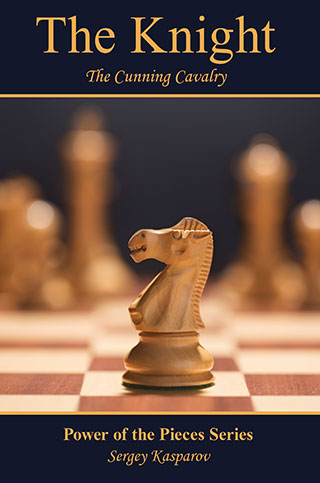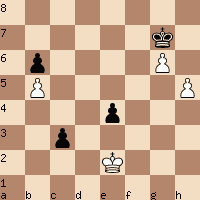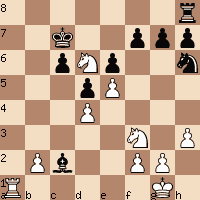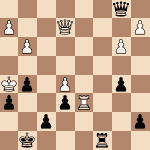Grandmaster Sergey Kasparov has undertaken an ambitious task in his fifties. He is writing one book about each chessman. Published by Russell Enterprises, the “Power of the Pieces Series” began with The Bishop: Danger on the Diagonal. The second book in the series is The Knight: The Cunning Cavalry.

by Sergey Kasparov
As shown in the linked excerpt, I edited and proofread Sergey Kasparov’s The Bishop: Danger on the Diagonal. An excerpt from The Knight: The Cunning Cavalry is available here. Both books are available for order here.
The Russell Enterprises’ site states: “This second volume in the series is about the knight. Its role in the opening, middlegame and endgame is discussed in detail, amply supported by almost 140 complete games from tournament praxis. Topics include: The Knight in the Endgame, the French Defense, the Rossolimo System, the Benkö Gambit; The ‘Spanish’ Knight; The Knight on the Attack; The Knight in Defense; The Cavalry Retreats; The Knight on an Outpost; A Knight on the Rim; The Kamikaze Knight; Knight versus Pawns; Knight versus Bishop; and Knight against Rook.”
A pawn endgame
If a pawn ending is won, the knight ending is won as well.
Since the excerpt at the Russell Enterprises’ site is about an opening—The Knight in the French Defense—I will share an idea from the “The Knight in the Endgame.” As S. Kasparov wrote, recalling a phrase he learned as a boy in Belarus, “If a pawn ending is won, the knight ending is won as well.” That means if you have an ending with just pawns on both sides, the result of that ending may be the same if a knight is added to each side.
Counter-examples happen, for example if one side’s knight is better placed than the other side’s knight. Let’s look at an example where having one knight on each side affects the result.
First, let’s look at the position without knights.

It is White to move. Recommended by Stockfish is 1. Ke3, which attacks Black’s e4-pawn. However, if White ever takes that e-pawn, Black’s c-pawn will promote. 1…Kh6. Here Black attacks the White h-pawn. In an interesting parallel to White’s quandary, Black cannot capture on h5 because then the White g-pawn will promote. 2. Ke2 Kg7 and neither side can make progress.
Pawns and knights endgame
Now let’s look at the position above, but with knights. As common in his books, Sergey Kasparov takes the position from one of his own games. He is White (and on move) versus FIDE Master Jan Vrana (Pardubice, 2012).
The position, after Black’s 43rd move, is identical to the diagram above except that there is a knight for each side. White’s knight is ideally placed to capture Black’s c- and e-pawns. 44. Kd1 Ne5 [44….Kh6 45. Kc2 and White has a large advantage] 45. Nxc3 Nd3 46. Nxe4 Nf4 47. Ng3 Nd5 48. Nf5+ and White wins, as “The pawns resume their advance.” More explanations are provided for this particular endgame position on pages 20-21 of The Knight: The Cunning Cavalry.
Since The Knight: The Cunning Cavalry is aimed at tournament chess players, it has rather sophisticated chapter titles, as indicated above. Thus, there is not a specific chapter featuring the most commonplace of knight tactics, the fork.
A puzzle from Sergey Kasparov versus Anna Rudolf
Here’s a position with not just a fork in the air but a follow-up skewer idea too! White to move and win a pawn. The game is Sergey Kasparov versus Anna Rudolf, Hoogeveen 2014 and is featured on pages 83-84 of The Knight: The Cunning Cavalry. This is the position just after Black’s 28th move.

The answer is 29. Nxf7 and if 29….Nxf7 then 30. Ra7+ skewers the black king to the black knight. Rudolf instead chose 29….Rb8 and resigned on move 37.
Rudolf is both a Woman Grandmaster (WGM) and an International Master (IM). Rudolf proclaimed, on her Twitter, that the knight is her favorite piece.

On her Facebook page, she posted a photo with some huge knights. I had hoped for a knight quote or knight position from Rudolf. However, she just returned from an emergency dental appointment and thus understandably did not reply to my request. Best wishes to her for a quick recovery, and for many great knight moves when she is back in the chess arena!
